Chapter: 11th Botany : Chapter 2 : Plant Kingdom
Pinus - Gymnosperms
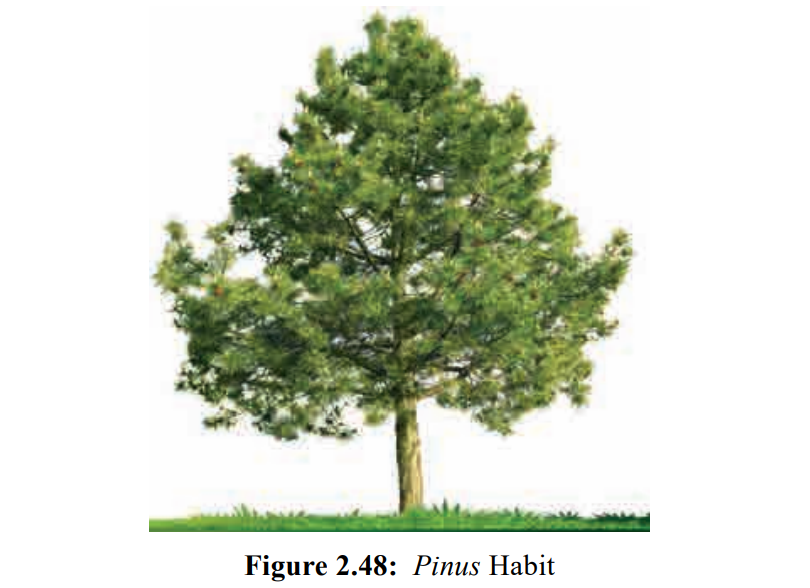
Pinus
Class – Coniferopsida
Order – Coniferales
Family –Pinaceae
Genus - Pinus
Pinus is a tall
tree, looks conical in appearance and
forms dense evergreen forest in the North temperate and sub-alpine regions of
the world. They mostly grow in high altitudes (ranging from 1,200 to 3,000
metres). Some species of this genus include, Pinus roxburghii, P. wallichiana,
P. gerardiana and P. insularis.
External features
The plant body is sporophyte and is differentiated
into root, stem and leaves.
The main stem is branched. The branches are
dimorphic with long and short branches (Figure 2.48).
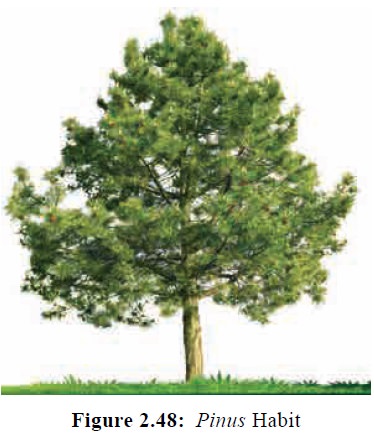
Root
Tap root system is found in Pinus. The root hairs are not well developed and the roots are
covered with fungal hyphae called mycorrhizae.
Stem
The stem is cylindrical, erect, woody and branched.
The branches are monopodial. The branches are of two types.
(i) Long shoots or branches of unlimited growth,
(ii) Dwarf shoot or branches of limited growth
(i)
Long
shoots or branches of unlimited growth
The long shoot is present on the main trunk the
apical buds grow indefinitely, They shorten gradually towards the tip, thus
providing a pyramidal appearance to the tree. These branches bear scale leaves
only.
(ii) Dwarf shoot or branches of limited growth
These branches do not have apical buds and hence
show only limited growth. They develop in the axils of scale leaves and bear
both scale and foliage leaves.
Leaves
There are two types of leaves 1. scale leaves, 2.
foliage leaves
1. Scale leaves:
They are dark, brown, membranous, thin and small.
They are present on both long and dwarf shoots. Their function is to protect
young buds. The scale leaves on the dwarf shoots have a distinct midrib and are
called “Cataphylls”.
2. Foliage leaves:
The foliage leaves are green angular and needle
like structures. They are borne on the dwarf shoot. A dwarf shoot with a group
of needle like foliage leaves is known as foliar
spur. The number of needles per dwarf shoot varies among the species. It
may be one (Pinus monophylla), two (P. sylvestris), three (P. geraradiana), four (P. quadrifolia) and five (P. excelsa).
Internal Structure
T.S. of root
The internal structure of root reveals the presence
of epiblema, cortex and stele.
The epiblema is made up of single layer of
parenchymatous cells. Cortex is the wide zone and consists of parenchyma. Some
of the cells have resin ducts. A single layered endodermis with suberised wall
is present and is impregnated with tannins.A multilayered pericycle made up of
parenchyma is present. Vascular tissue is radial, diarch with exarch xylem. The
protoxylem bifurcates to form a ‘Y’ shaped structure and a resin duct lies in
between the two arms of protoxylem. Secondary growth is present (Figure 2.49).
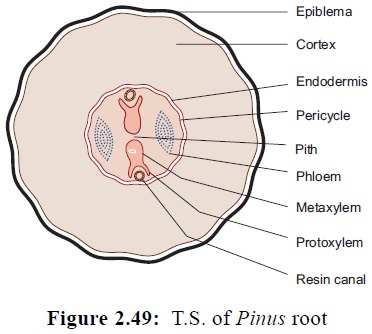
T.S. of Stem
The internal organization of the stem shows three
regions namely epidermis, Cortex and vascular tissue (Figure 2.50).
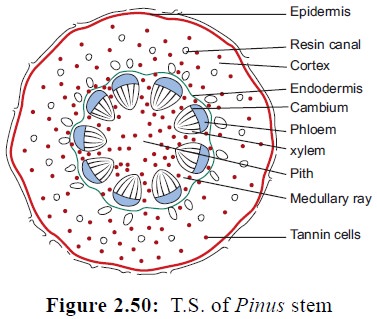
Epidermis is the outermost layer composed of
compactly arranged and heavily cutinized cells. Epidermis is followed by few
layers of sclerenchymatous hypodermis. The cortex consists of thin walled
parenchyma cells. Resin canals and tannin filled cells are present in this
region. Endodermis is indistinguishable from cortical cells. Vascular region is
surrounded by pericycle. A ring consists of five or six vascular bundles are
present. Vascular bundles are conjoint, collateral, open and endarch. Pith and
medullary rays are present. Secondary growth is present and annual rings are
formed.
T.S. of needle or foliage leaf
The internal structure of needle shows xerophytic
adaptations. In cross section the outline appears more or less triangular and
is divided into epidermis, mesophyll and vascular bundles. The epidermis is
single layered and possesses thick cuticle and sunken stomata.Epidermis is
followed by a few layers of sclerenchymatous hypodermis. It is interrupted by
sub-stomatal cavities (Figure 2.51).

Mesophyll is not differentiated into palisade and
spongy parenchyma. Thin walled cells with chloroplasts are present. The cells
are peculiar with numerous small infoldings which project into the cavities.
The infoldings increase the photosynthetic area of the needle leaves Resin
canal is present in the mesophyll. A single layered endodermis separates the
vascular region from the cortex. A multilayered pericycle containing starch is
present. Two types of specialised cells called albuminous cells and tracheidal
cells are present. The former helps
to pass substances from the mesophyll to the phloem while the latter helps in
water conduction and constitutes transfusion tissue. Two vascular bundles are
present. They are separated by sclerenchyma tissue. The Vascular bundles are
conjoint, collateral and open.
![]()
![]()
![]()
Reproduction
Pinus is
heterosporous and produces two types
of spores called. microspores and megaspores. The plants are monoecious. Both
male and female cones or strobili develop on the different branches of the same
plant (Figure 2.52).
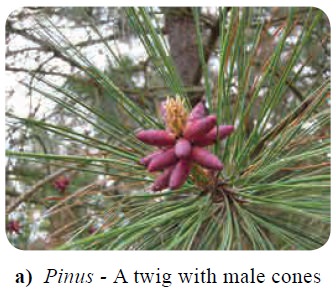

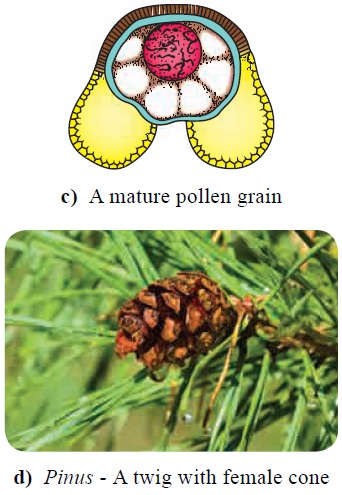
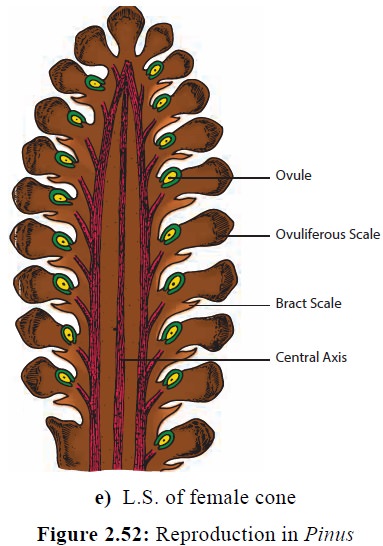
Male cone
Male cones are produced in clusters on branches of unlimited growth. Each cone develops on the axil of scale leaf . The male cone consists of a centrally located cone axis surrounded by numerous spirally arranged microsporophyll. It bears two microsporangia at the base of the abaxial side of the microsporophyll. Each sporangium bears numerous winged microspores (n) or pollen grains. The microspores represent the male gametophyte.
![]()
![]()
![]()
Female cone:-
Female cones are formed in the groups of 1 to 4 in the axils of the scale leaves. The female cone takes about three years to mature. It has the central axis around which megasporophylls are arranged spirally. The megasporophyll is the compound structure consisting of two types of scales. 1. Bract scale (sterile), and 2. Ovuliferous scales (fertile). The dorsal surface of each ovuliferous scale bears two ovules. Ovules bear megaspores which represent the female gametophyte.
Pollination and fertilization
In Pinus
wind pollination takes place (Anemophilous). The microspore or pollen grain is
released in the 4 celled stage(two prothallial cell, 1 generative and 1 tube
cell). At the time of pollination a secretion oozes out from the micropyle of
the ovule which entangles pollen grains which helps to lodge them in the pollen
chamber. The tube cell protrudes to form pollen tube. The generative cell
divides to produce stalk cell and body cell. The body cell divides into unequal
male cells. Fertilization takes place after about a year of pollination. The
pollen tube containing two male nuclei penetrates through the micropyle and
reaches the egg. One of the male nuclei fuses with the egg forming diploid
zygote and the remaning one gets degenerated. The fertilized egg
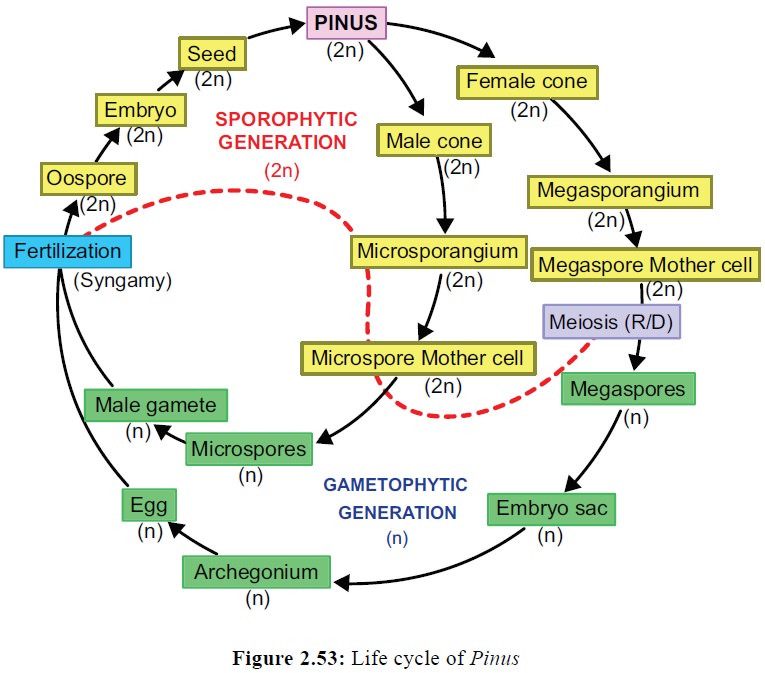
Polyembryony is present. The embryo undergoes several changes
and finally becomes a winged seed. The seed germination is epigeal. Life cycle
of Pinus shows alternation of
generation (Figure 2.53).
Related Topics